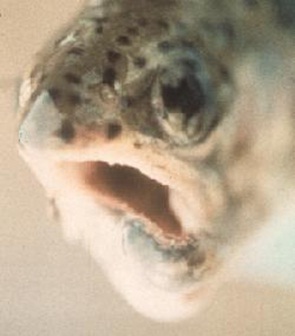Difference between revisions of "Whirling Disease"
From Glen Canyon Dam AMP
(add AZFG WD- Deformed Face.jpg) |
(add wd insights) |
||
| Line 8: | Line 8: | ||
---- | ---- | ||
| − | == | + | == CLIFF NOTE VERSION == |
*Whirling disease is a parasitic condition affecting fish, primarily rainbow trout. | *Whirling disease is a parasitic condition affecting fish, primarily rainbow trout. | ||
| − | |||
*Young fish are at greatest risk. | *Young fish are at greatest risk. | ||
*First observed in the United States around 1958. | *First observed in the United States around 1958. | ||
| Line 17: | Line 16: | ||
*Currently, No practical cure to treat wild trout infected with the disease. | *Currently, No practical cure to treat wild trout infected with the disease. | ||
*Once the disease parasite is established in the wild, it can persist indefinitely | *Once the disease parasite is established in the wild, it can persist indefinitely | ||
| + | *SIGNS INCLUDE: Whirling behavior- Blackened tail -Skeletal deformities | ||
| + | *WD has been identified in 25 states (2009) | ||
| + | *Trout species only- rainbow trout: highly susceptible, brown trout: can carry parasite, but generally do not show clinical signs | ||
| + | *Trout become resistant after 4-8 months | ||
| + | *Not harmful to humans, trout in WD infected waters are ok to eat | ||
| + | *Spore are very resistant | ||
Revision as of 11:11, 31 October 2012
- Whirling Disease AZ Game and Fish
- State of Colorado Parks and Wildlife- Whirling Disease and Colorado's Trout
CLIFF NOTE VERSION
- Whirling disease is a parasitic condition affecting fish, primarily rainbow trout.
- Young fish are at greatest risk.
- First observed in the United States around 1958.
- Larger infected fish generally don't die but are carriers of the disease.
- Warm-water fish such as bass, walleye and catfish are not affected.
- Currently, No practical cure to treat wild trout infected with the disease.
- Once the disease parasite is established in the wild, it can persist indefinitely
- SIGNS INCLUDE: Whirling behavior- Blackened tail -Skeletal deformities
- WD has been identified in 25 states (2009)
- Trout species only- rainbow trout: highly susceptible, brown trout: can carry parasite, but generally do not show clinical signs
- Trout become resistant after 4-8 months
- Not harmful to humans, trout in WD infected waters are ok to eat
- Spore are very resistant
